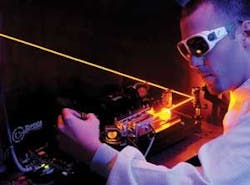Large ground-based telescopes can use a sodium “guidestar” to enable active compensation of atmospheric disturbances using adaptive optics and making possible high-resolution ground-based astronomical observations. A guidestar is created by excitation of the atmospheric sodium layer (D2 line) using a powerful 589 nm laser to generate strong resonance fluorescence.
Existing laser guidestar systems are typically cumbersome and based on dye lasers or sum-frequency systems. At the Laser, World of Photonics event in Munich last month, Toptica Photonics (Graefelfing, Germany) and MPB Communications (Montreal, Canada) showcased a novel guidestar laser based on the European Southern Observatory's narrowband fiber Raman laser technology. The partners’ design delivers more than 20 W single-mode output at 589 nm. “Our approach holds the promise that the output power can be extended well beyond 20 W, to a level that the next-generation telescopes may require,” says Toptica’s President Wilhelm Kaenders.
